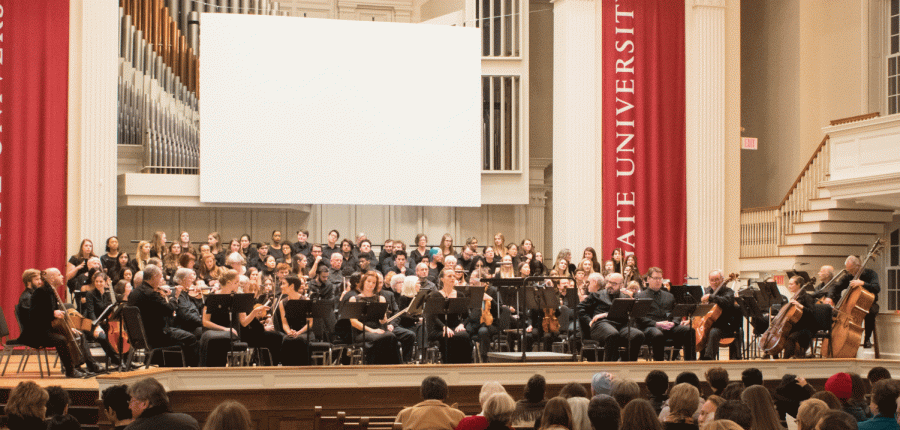“The Passion of Joan of Arc”: Silent Film Speaks Volumes
One hundred twenty-seven performers assembled in the Colgate Memorial Chapel on Friday, December 7 to perform “Voices of Light,” a 1994 musical composition by Richard Einhorn, in tandem with the 1928 silent film, “The Passion of Joan of Arc.” The event was the result of a collaboration between the Film and Media Studies Program and Music Department.
The performance included six professional singers featured as soloists, 30 instrumentalists and 90 chorus singers. The chorus rehearsed the music for this event for the past nine weeks, averaging around three hours of rehearsal time each week. On the days leading up to the event, the orchestra held two three-hour rehearsals in preparation.
Director of Choral and Vocal Activities Ryan Endris divulged what his greatest challenge was.
“Coordinating the music with the film was by far the greatest challenge for me as the conductor. Normally when preparing a work for chorus, orchestra and soloists, my sole focus is the music; with the film as an added element of the performance, I had to divide my attention frequently. I spent many hours studying the film and writing in my score visual cues to make sure I was staying in time with the film,” Endris said.
Professor of Art Lynn Schwarzer commented on the benefits of collaboration between departments along with the experiences that result from them.
“Amongst people I talked to it was one of the most significant arts events Colgate has held in maybe…ever,” Schwarzer said. “This event is evidence of the potential for what happens when art departments collaborate, and when a vision comes to full fruition. For myself and the other professors I have talked to, we know we were experiencing the profound.”
“The Passion of Joan of Arc” depicts the imprisonment, trial and execution of Joan of Arc in 1431. Tight shots that framed her face forced the audience to be actively engaged with Joan of Arc’s emotions, and the powerful vocal and orchestral accompaniment to the black and white feature moved audience members to tears. The performance took the protagonist from the pages of a history book and presented her as a 19 year old desperately trying to uphold her beliefs in the face of insurmountable opposition.
“There is a long and noble history of women in medieval Europe who sought to break out of gender norms,” said Lynn Staley, a professor of Medieval and Renaissance Studies. “They were not feminists, in our sense of the term, but their understanding and exploitation of gender roles is every bit as subtle as our own and offer us a historical perspective on the tensions that exist between individual and community,” Staley said. “I’ve never been particularly interested in silent films, but watching “The Passions of Joan of Arc” was truly a powerful experience. The choral and orchestral accompaniments made the movie more engaging, and I was moved by Joan’s struggle to express herself and her beliefs against all odds,” said junior Laura Mucha.
Joan of Arc stood in defiance of the patriarchal structures at play in her world and rejected the traditional expectations of her gender. The power of her story, and of this performance, resonated in the walls of the chapel as well as in the minds of the individuals who were there to experience it.
“The Joan of Arc extravaganza took my breath away; the movie, the beautiful
voices and the powerful music worked together wonderfully. It was an emotional experience,” junior Margaret Pulte said.
Contact Alexandra Weimer at [email protected].






